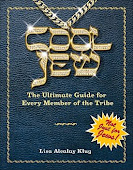My latest Heebster creation, a Cool Jew-inspired "seder plate" is on display at the Contemporary Jewish Museum. Read all about it in the San Francisco Chronicle!
Artists reflect on the seder plate
Laura Thomas, Chronicle Staff Writer
Sunday, April 5, 2009
When asked to reflect on Passover and put her thoughts into an artistic creation, Mildred Howard of Berkeley lined up 28 bottles of Manischewitz wine labeled with pictures of her friends and family to express values of suffering and joy shared by Jews and African Americans.
Her installation is one in a current exhibition, "New Works, Old Story: 80 artists at the Passover Table," at the Jewish Contemporary Museum in San Francisco that's intended to nurture new insights into the Passover feast by reinterpreting its central symbol, the seder plate.
"It is our signature exhibition. We always invite a range of artists, so they are not all Jewish, and the idea is to offer a range of perspectives," said associate curator Dara Solomon.
She said the museum has done an invitational series every three to five years since 1984 and has focused on other ceremonial objects such as the menorah, Purim masks, kiddush cups and spice boxes for Havdalah. The series has been given an endowment by museum trustee Dorothy Saxe of Menlo Park, an avid collector of contemporary craft.
Passover marks the flight of the Israelites from Egypt across the desert and the parting of the Red Sea to allow them to escape the Pharaoh. The celebration recalls the event and allows Jews to reflect on its contemporary meaning.
It centers on a dinner completed in ritualistic fashion with symbolic foods and readings from the Haggadah, a book of songs, prayers and verses, and is the most widely celebrated by Jews.
Despite its basic structure - seder means "order" in Hebrew - it can get disorderly. "There's always an argument about how it was done in your family," said Connie Wolf, museum director.
Nonetheless, the seder plate remains a universal feature and each family usually has one plate, an heirloom or contemporary version that is the meal's centerpiece, she said.
With an obvious functional focus for artists working in the now-converging fields of craft, design and fine art, the exhibition offers an eclectic commentary in objects fashioned from recycled goods, textiles, ceramics, wood, glass and plastic.
Some, like Howard's, don't have anything to do with plates, but the spirit of recalling Passover is there.
An artistic turn
San Francisco artist Liz Mamorsky created the "Lazy Daisy Seder Plate" on a lazy Susan concept with casting components scrounged at Mare Island Naval Shipyard.
"Everything I read of seder plates conveyed the notion of movement - passing over," she said.
With wheels on the bottom tier, it can swivel. "Now my plate can truly rock and roll," she said.
Deborah Lozier of Oakland chose to concentrate on the symbolic foods of the Passover feast, making separate objects, exquisite in their detailing, of the apple, romaine lettuce, egg, red beet, parsley and orange in etched copper and vitreous enamel.
Following a Jewish tendency toward humor and irreverence, Lisa Alcalay Klug made a plate from CDs of Passover songs from different eras topped by a glittering disco ball, commenting that she was trying for a "Heebster" aesthetic. (more)
Monday, April 6, 2009
Seder Plates
Subscribe to:
Post Comments (Atom)





No comments:
Post a Comment